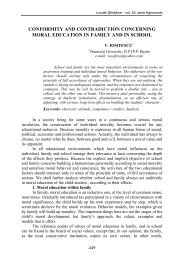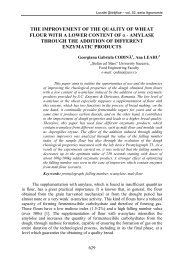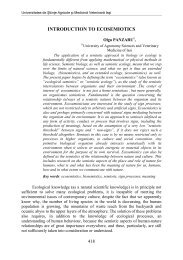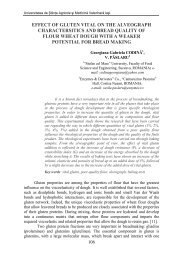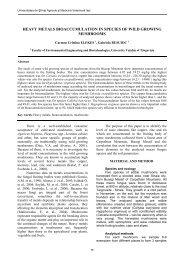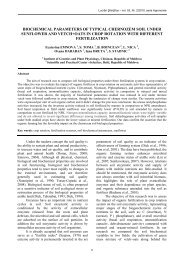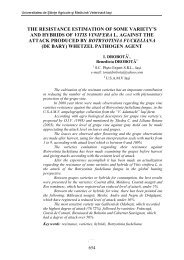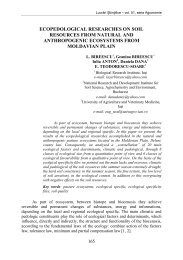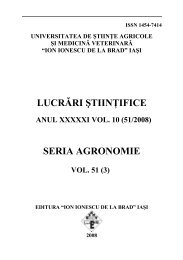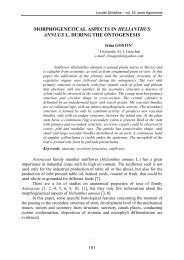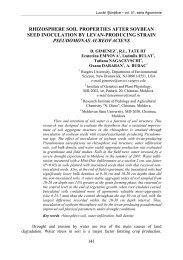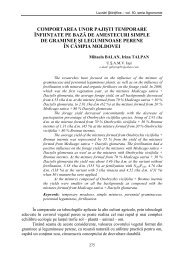environmental impact on yield of pea and okra grown under ...
environmental impact on yield of pea and okra grown under ...
environmental impact on yield of pea and okra grown under ...
You also want an ePaper? Increase the reach of your titles
YUMPU automatically turns print PDFs into web optimized ePapers that Google loves.
Lucrări Ştiinţifice – vol. 50, seria Agr<strong>on</strong>omie<br />
Efficiency <strong>of</strong> Intercropping<br />
When the values <strong>of</strong> l<strong>and</strong> equivalent ratio (LER) ap<strong>pea</strong>r greater than <strong>on</strong>e<br />
<strong>under</strong> intercropping system, this usually indicates the efficiency <strong>of</strong> this system over<br />
the sole cropping system. However, LER is defined as the relative l<strong>and</strong> area <strong>under</strong><br />
sole cropping that is required to produce the <strong>yield</strong> achieved in the intercropping.<br />
Table 4, shows that when <strong>okra</strong> <strong>and</strong> <strong>pea</strong>s were planted <strong>under</strong> different row<br />
arrangements (1:1, 1:2, 2:1, 2:2), the total LER values obtained were higher than<br />
<strong>on</strong>e <strong>and</strong> ranged between 1.16 to 1.58. It is also clear that the efficiency <strong>of</strong><br />
intercropping was affected by row arrangements. This is logical since each row<br />
arrangement allowed the planted crops special local microenvir<strong>on</strong>ment, changing<br />
to a certain limit the competiti<strong>on</strong> for light, moisture <strong>and</strong> nutrients. The highest<br />
relative LERs were obtained when <strong>okra</strong> was planted with <strong>pea</strong>s <strong>under</strong> 2:1 <strong>and</strong> 2:2<br />
row arrangements where <strong>okra</strong> gave 1.093 <strong>and</strong> 0.738, respectively. These values are<br />
0.436 <strong>and</strong> 0.238 higher than expected LER values obtained for <strong>okra</strong> sole crop<br />
planted in two thirds <strong>and</strong> <strong>on</strong>e half <strong>of</strong> the l<strong>and</strong> where LER equal to 0.666 <strong>and</strong> 0.50,<br />
respectively. On the other h<strong>and</strong>, the highest relative LER obtained by <strong>pea</strong>s when it<br />
was planted with <strong>okra</strong> <strong>under</strong> 2:1 where it gave an increase <strong>of</strong> 0.29 over the <strong>pea</strong> sole<br />
crop planted in 2/3 <strong>of</strong> the l<strong>and</strong>.<br />
Table 3<br />
The effect <strong>of</strong> crop combinati<strong>on</strong> <strong>and</strong> row arrangement <strong>on</strong> <strong>yield</strong>s <strong>of</strong> <strong>okra</strong> <strong>and</strong> <strong>pea</strong>s<br />
during summer growing seas<strong>on</strong> <strong>of</strong> 2002<br />
Intercropping<br />
Yield Kg ha¯¹<br />
Yield Kg ha¯¹<br />
Treatments<br />
Pea<br />
Okra<br />
1 Row <strong>pea</strong><br />
9312.7<br />
11303<br />
1 Row <strong>okra</strong><br />
ab<br />
ab<br />
1 Row <strong>pea</strong><br />
11214<br />
16706<br />
2 Row <strong>okra</strong><br />
a<br />
a<br />
2 Row <strong>pea</strong><br />
11022<br />
16123<br />
1 Row <strong>okra</strong><br />
a<br />
a<br />
2 Row <strong>pea</strong><br />
9870.7<br />
15026<br />
2 Row <strong>okra</strong><br />
Pea<br />
Sole crop<br />
ab<br />
7701<br />
b<br />
a<br />
10186<br />
b<br />
Table 4<br />
The relative <strong>yield</strong>s, relative LER <strong>and</strong> total LER <strong>of</strong> <strong>okra</strong> <strong>and</strong> <strong>pea</strong>s <strong>grown</strong><br />
<strong>under</strong> different intercropping row arrangements<br />
Row Arrangements Yield kg ha¯¹<br />
Relative LER Total LER<br />
Pea Okra Pea Okra Pea Okra<br />
1 row : 1 row 4656.3 5651.5 0.6o5 0.555 1.160<br />
1 row : 2 rows 3738 11137.3 0.485 1.093 1.578<br />
2 rows : 1 row 7348 5374.3 0.954 0.528 1.482<br />
2 rows : 2 rows 4935 7513 0.641 0.738 1.379<br />
The higher efficiency <strong>of</strong> intercropped <strong>okra</strong> <strong>and</strong> <strong>pea</strong>s found in this study<br />
agreed with the results obtained by Willey (1979) <strong>and</strong> Al Qahwaji (1995) who<br />
explained this phenomen<strong>on</strong> by the complimentary use <strong>of</strong> growth resources over<br />
time <strong>and</strong> space. Moreover, when total LER is c<strong>on</strong>sidered, the highest values were<br />
321




